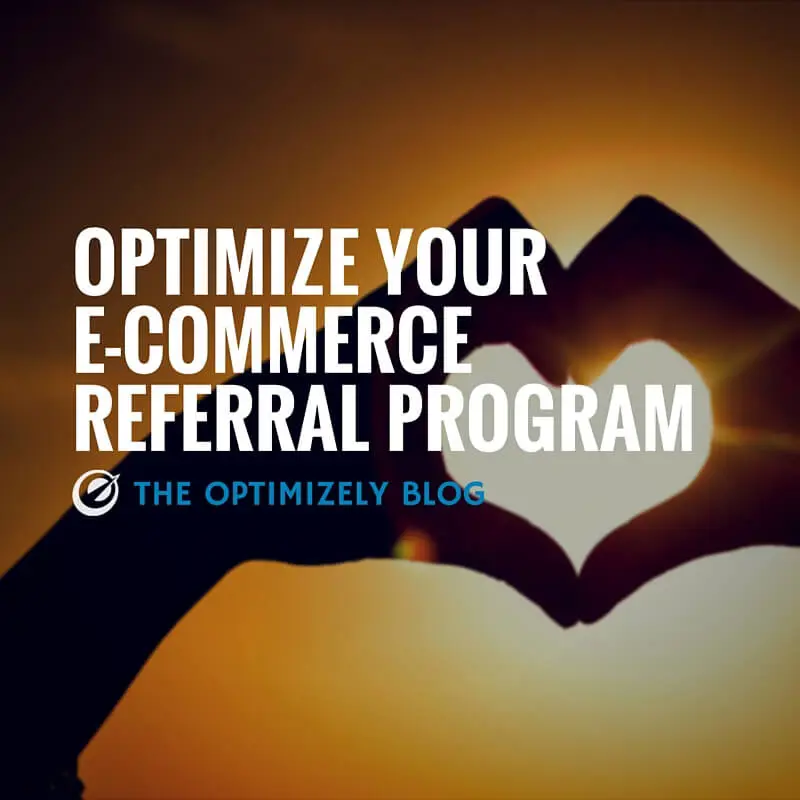4 Steps to Optimize Your E-commerce Referral Program
If you’re running a successful e-commerce store, you’d already have staked out multiple marketing channels – email marketing, PPC ads, social media content, retargeting, YouTube videos

Dinesh Raju

But have you considered running a referral program?
As it turns out, referral marketing is one of the highest ROI marketing activities. It helps you get high-quality customers who spend more and stick around for longer.
It’s also especially worthwhile because you only pay for what you get – you don’t have to pay out rewards to people who don’t make referrals.
At ReferralCandy, we’ve helped thousands of successful e-commerce retailers earn millions of dollars in referral revenue. Let’s go through the process of optimizing a referral program to maximize profitability and brand awareness.
How to optimize your referral conversion funnel:
There are 4 numbers you want to care about when running any referral program:
- Participation rate – the number of people who sign up to become advocates in your referral program
- Share rate – the number of referral link shares (these are the personalized links that you provide to advocates to share with their friends)
- Referral link clickthroughs – the % of referral links shared that get clicked on, bringing people to your site
- Referral conversions – the value of referral sales you get, which will help you get a sense of the Cost Per Acquisition (CPA) of your referral program
Let’s go through the specifics of how these numbers work, and the various touchpoints that you’ll need to optimize in order to get the maximum bang for your buck.
1. Participation rate
How do you maximize the number of people who sign up for your referral program?
Variables:
- Number and placement of Referral CTAs
- Number of existing customers invited to become advocates
- Effectiveness of referral landing page
The more advocates you have participating in your referral program, the more customer referrals you’re potentially going to get.
You want to lean hard on this one – you won’t get any referrals if people can’t even find your referral program.
1: Add clear referral CTAs in your e-commerce site’s navigation so visitors know they can refer


It sounds obvious, but it’s sometimes overlooked by busy retailers. You want to make it clear to your visitors that they can benefit from referring friends to your store.
Here’s a list of examples of well-placed referral CTAs in e-commerce sites.
2: Invite existing customers to sign up for your referral program – they’re your best assets

Your existing customers are an incredibly powerful source of new customer referrals. They’re already using your product. They already know how and why it works. And chances are, they know other people who have the same needs as them.
You’ll definitely want to email your customers and invite them to your referral program.
3: Make your referral landing page as compelling as possible (make it bold but keep it simple)

Your potential advocates will land on your referral landing page when they click on your referral CTA — whether it be on your site, in an email, on social media, etc. This is the moment you prompt them to join or take an action such as sharing a link or emailing their friends.
You’ll want to make sure that it has a strong hero image that represents your brand , and you’ll want to use strong, simple copy that emphasizes what’s in it for them and their friends when they make referrals. [example] This landing page is a great candidate for A/B testing to discover the most compelling message that drives customers to sign up.
2: Sharing rate
How do you maximize the % of advocates who share, as well as the number of times they share?
Variables:
- Perceived value of incentives
- Effectiveness of messaging
- Top-of-mindedness
There are two parts to incentivizing your advocates to share.
1: Extrinsic incentives – appeal to self-interest
It makes a significant difference when you add a literal cash or discount reward to make it worth the advocate’s time. A study by Software Advice found that over half of 2,300 respondents said they were likelier to make a referral if directly incentivized.
How much to incentivize, exactly? A super-rough rule of thumb is to offer roughly 10-15% of the value of your product, or whatever works well for your other marketing channels.
If your advocates are likely to make repeat purchases, give a discount. Consider the Rule of 100– if your product costs over $100, give a dollar-discount (eg. $25 off), and if your product costs less than $100, give a %-discount (eg. 20% off).
If your advocates are unlikely to make repeat purchases, give cash rewards.
2: Intrinsic incentives – appeal to social interests
You want to appeal to the advocate’s desire to help their friends, as well as to whatever motivations your customers typically have when buying your product. That means making sure your messaging is on point.
Goldieblox, which makes educational toys for girls, does this really well.
They recognize that their customers don’t just want to buy toys, they want to participate in social change. That’s a huge part of the premise of the brand itself, and so they weave it into all of their copy– including the copy on their referral program.

So when you send a friend a referral link to Goldieblox, you aren’t just giving them a discount on a toy – you’re inviting them to join you on a greater mission for good.
3: Top-of-mindedness – post regularly to social media about your referral program to jog your advocates’ memory

People don’t always immediately know that they want to share. They might only be interested in making a referral after they’ve recently heard from a friend who needs it.
Beyond that, it can also take multiple reminders for somebody to remember something.
In both cases, it’s a good idea to remind your social media followers regularly about your referral program.
But that’s not all. An Advisor Impact study revealed that the main reason happy advocates fail to make referrals is that they don’t recognize referral opportunities in the first place. So you want to make sure that you’re using your social media posts to educate your advocates about how to spot referral opportunities.
Finally, you want to avoid flooding your social media feed with requests for referrals and nothing else. Make sure you’re posting quality content first!
4. Optimize your referral emails – make them bold and simple, just like the referral landing page
The job isn’t done once you email your advocates – you want to make sure that the emails you send them maximize their likelihood of subsequently making a referral.
- Subject Line: Have a clear, personal subject line that emphasizes the benefit to the customer.
- Simplicity: Keep the email itself simple with a clear call-to-action (the more time your advocates have to spend deciphering your email, the less likely they are to follow through)
- Branding: You want to make sure that your brand is strongly, clearly represented. Have your logo clearly visible. The reader shouldn’t have to guess who the email is from.
- Copy: Have copy that ties in with your customers’ motivations. Why do they like your product? Emphasize that.
Beyond that, you can also get creative! Brooklinen, for example, adds a fun GIF to their referral emails that directly shows the benefit.

For a much more extensive guide to optimizing referral emails, check out How To Write Great Emails Asking For Referrals.
3: Clickthroughs
How do you optimize the clickthrough of referral links?
Variables:
- Default sharing message
- Twitter/FB card images
1: Optimize default social sharing message

Image: ReferralCandy allows you to modify default sharing messages and images
When sharing your referral link, most advocates will simply use the default sharing message that you give them [source], so make sure that it’s appealing.
You’ll want to use similar messaging to what works for you when selling your product. So if you find through your FB ads that your customers prefer product specs (“10 gigapixels”) to user stories (“Take Better Selfies”), then you’ll want to keep that consistent.
Sometimes people do modify the default message – pay attention to those. If they do particularly well, your advocates could actually be improving on your marketing. Steal those ideas!
2: Twitter cards and Facebook images

An example of a referral link in the wild
A social share can include a strong product image to entice friends of advocates to buy. People are visual creatures, and the same factors that make strong product images convert better in your store make advocates likelier to click on referral links.
4. Referral conversions
How do you maximize the amount of revenue you get from your referral program?
Variables:
- Participation rate
- Sharing rate
- Clickthrough rate
- Baseline effectiveness of sales
Sales! This is the primary objective of running a referral program. To maximize your referral sales, you simply need to optimize the earlier parts of the funnels. Make it easy for people to sign up for your referral program, make it easy for them to share your referral links, and make it compelling for their friends to click on those links. After that, it’s all about your fundamental sales process.
After celebrating your newfound sales, you’ll want to investigate the ROI of your marketing spend on your referral program. You get this by comparing the monthly revenue from referral sales to the amount that you’re spending on your referral incentives (for both the advocates and their friends).
Once you’ve set up your basic referral campaign, experiment with your variables in subsequent campaigns.
While you should have a scientific-minded approach to setting up referrals, you don’t want to add too much variation within a single campaign. Customers can get upset if they find out that somebody else got a better discount or reward for making the same referral, for example.
Instead, it may be worth testing different refer-a-friend offers in separate campaigns – offer one promotion for 6 months, then end the campaign, and launch another with a different promotion afterwards.
You can also try optimizing your landing pages using different copy, different images, different CTAs and in the referral emails as well.
Here’s a quick recap of what you need to do to get the maximum ROI for your customer referral program:
Optimize your Participation Rate
- Place your referral CTAs prominently in your site navigation
- Invite existing customers to make referrals
- Make your referral landing page as compelling as possible with A/B testing
Optimize your Sharing Rate
- Set up appropriate incentives (extrinsic + intrinsic)
- Optimize your referral emails
Optimize your Clickthrough Rate
- Have a good default sharing message
- Use effective visuals in Twitter/FB cards
Have you ever participated in a referral program for a brand you like? What was special about it that made you want to share?
